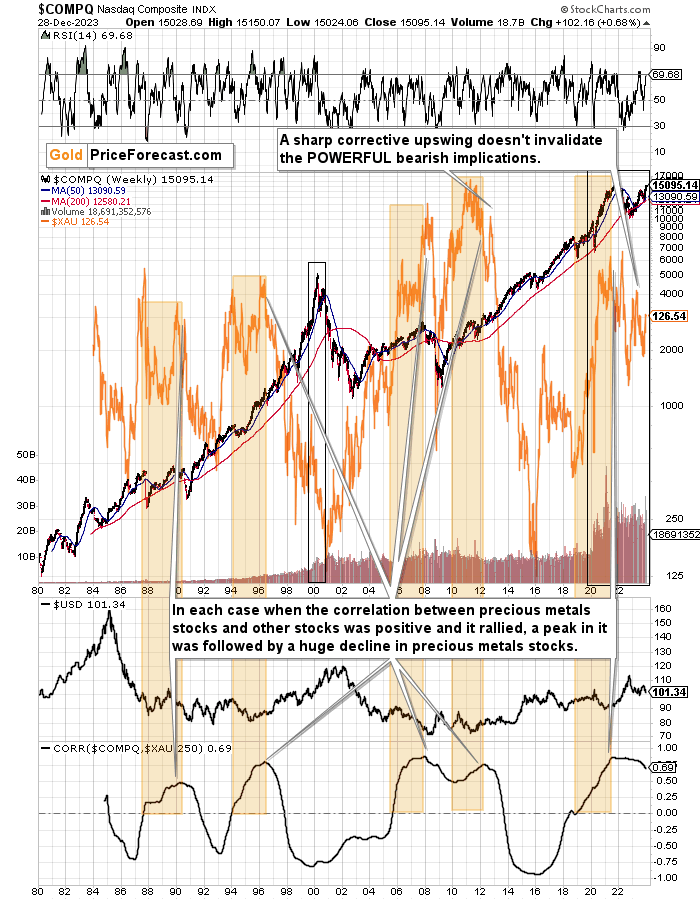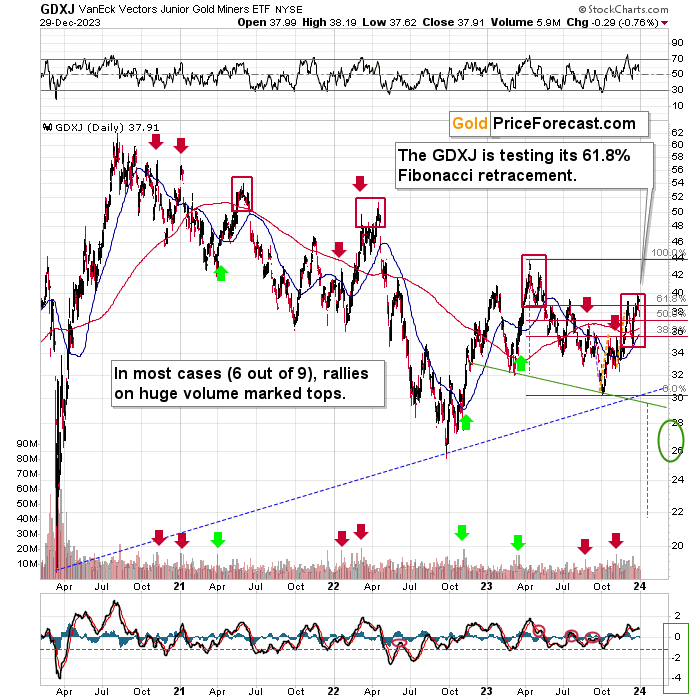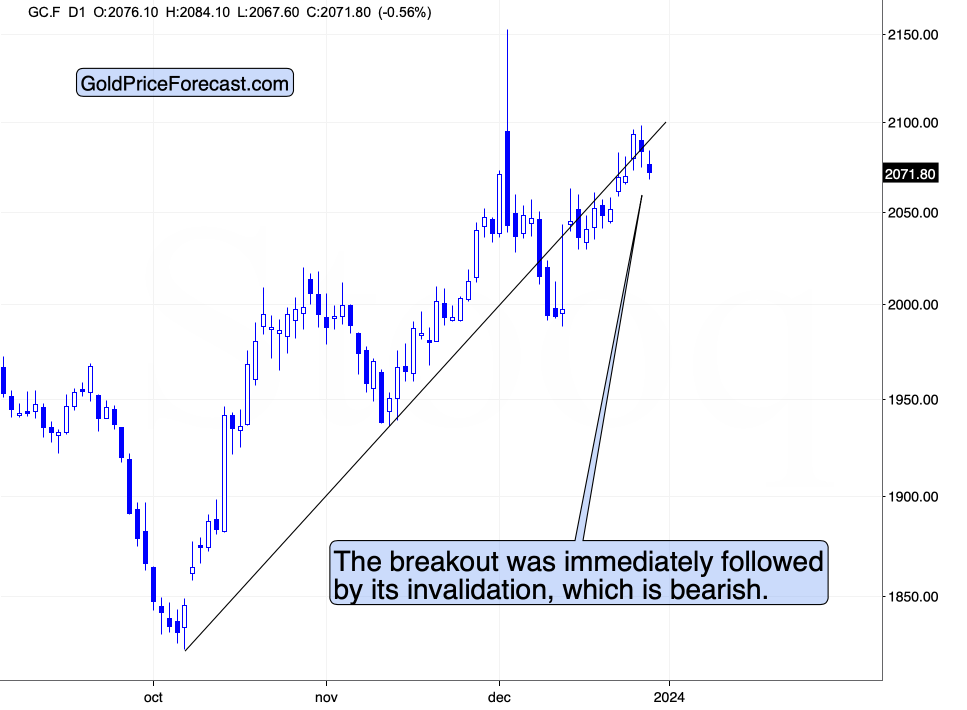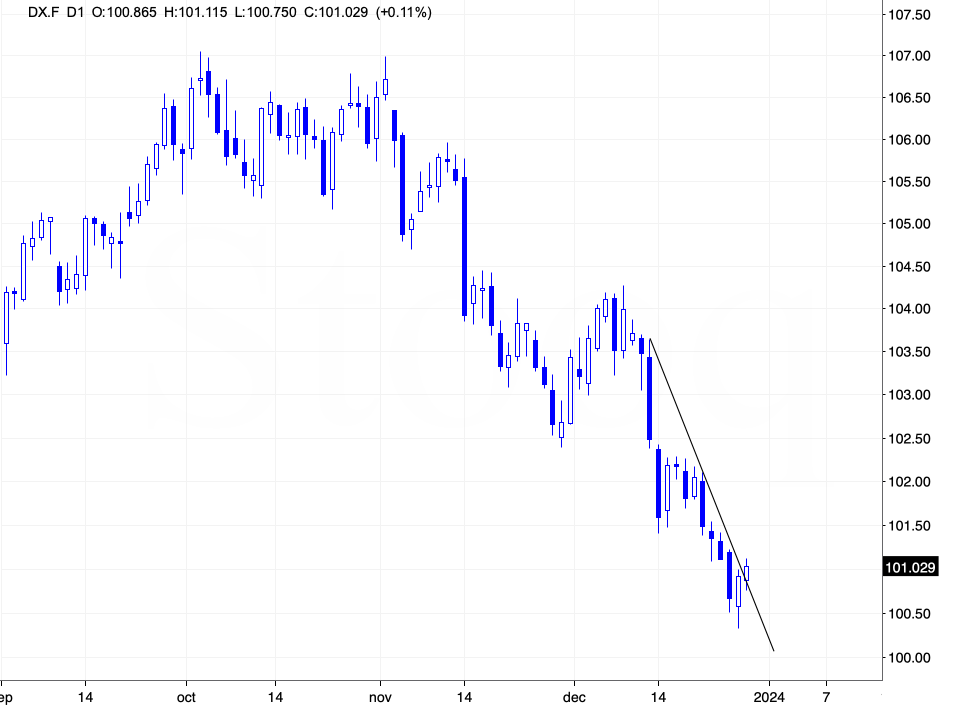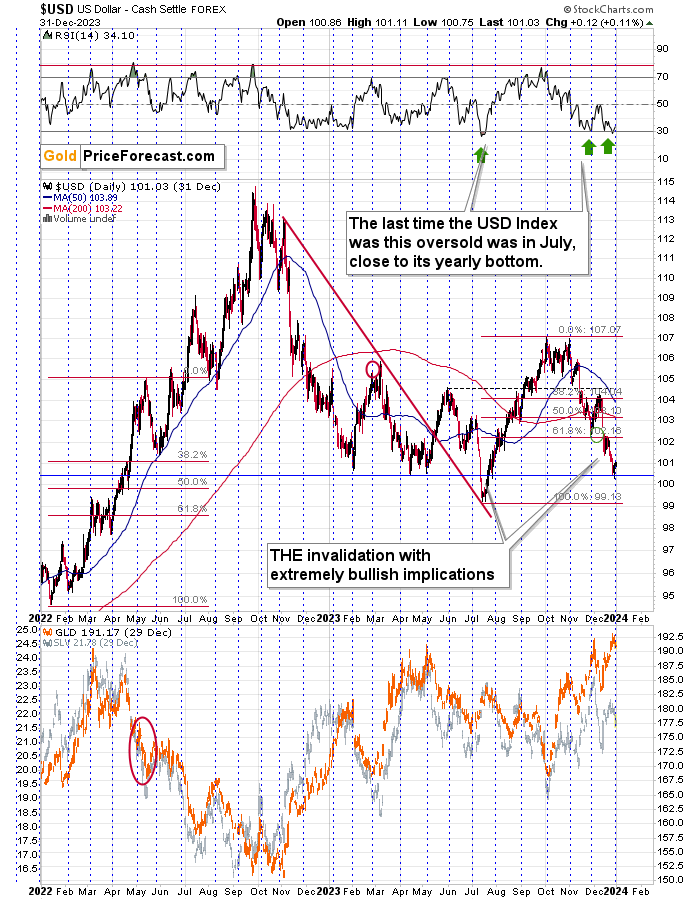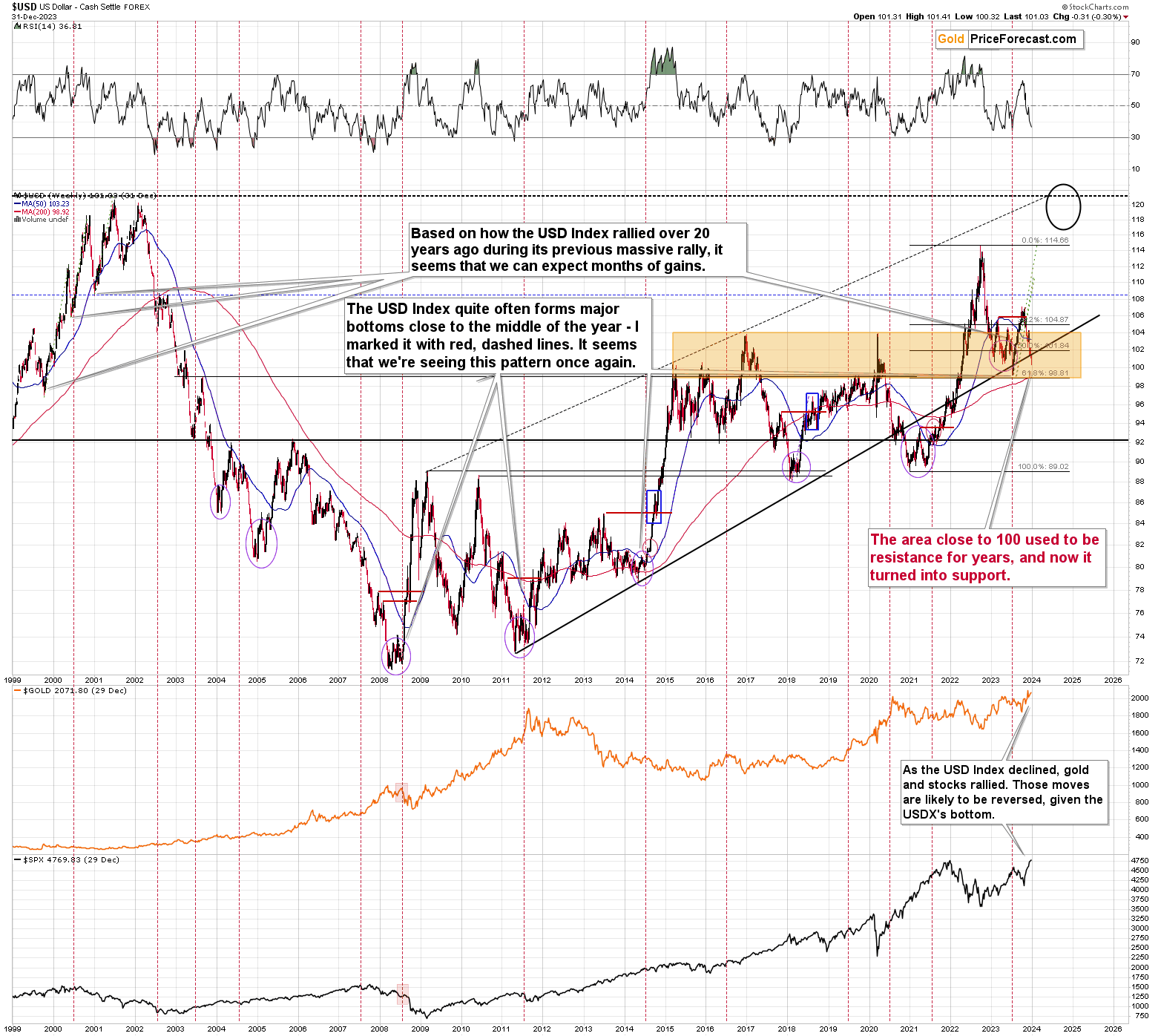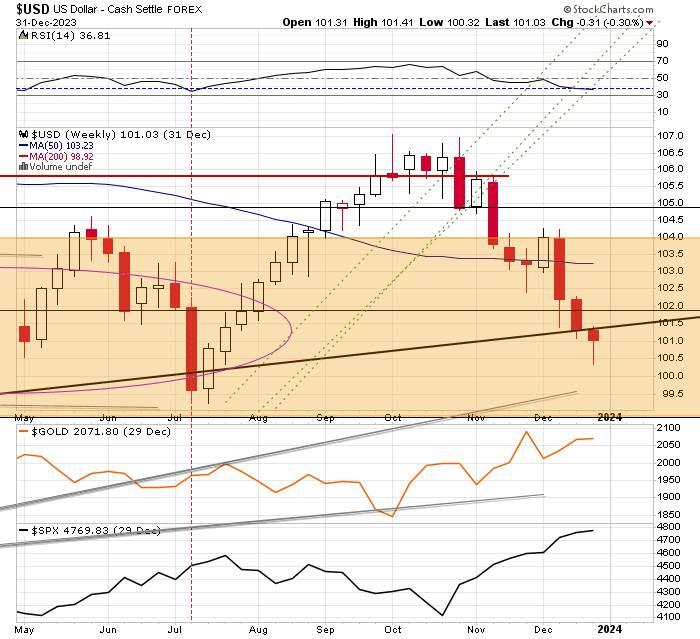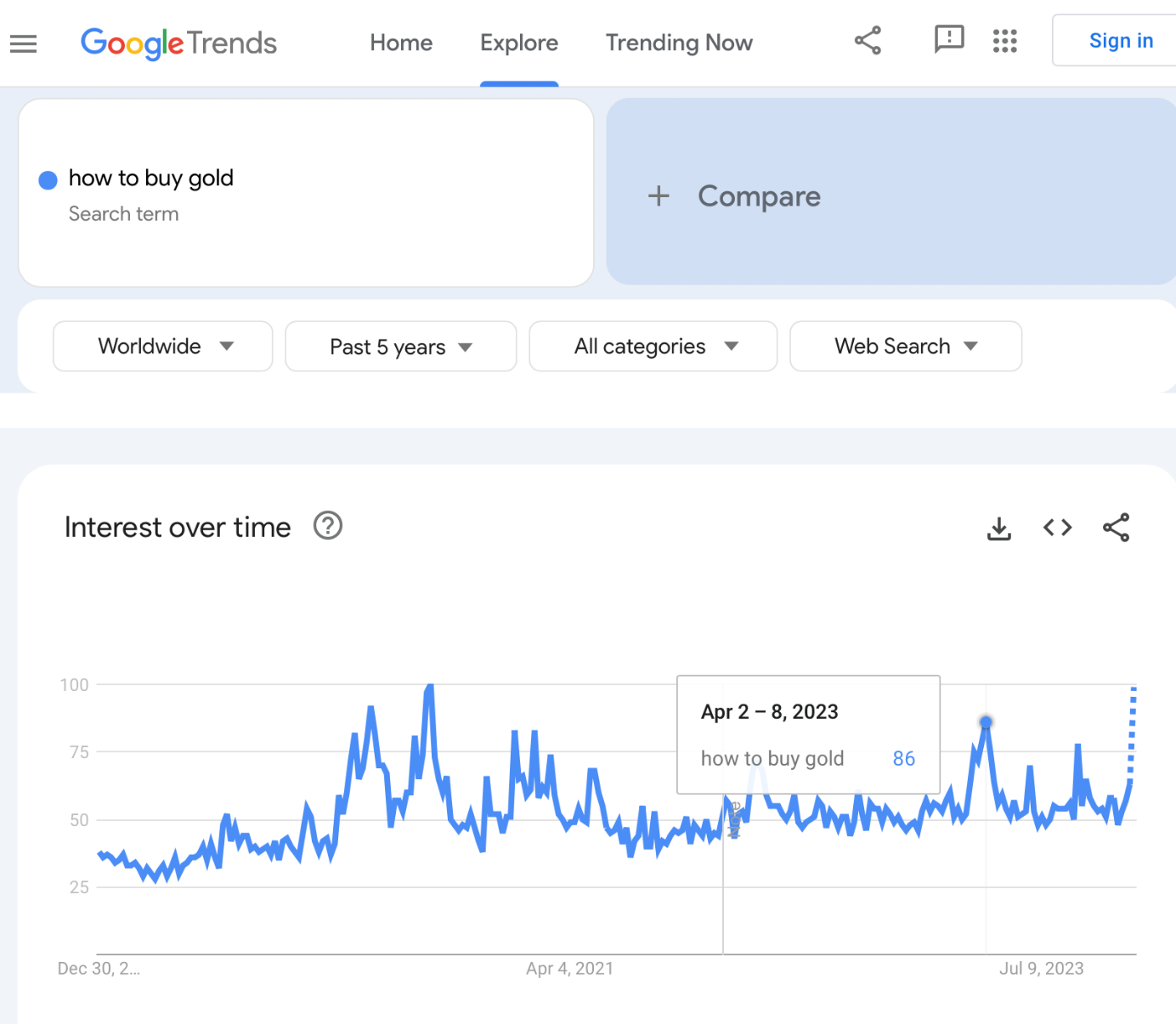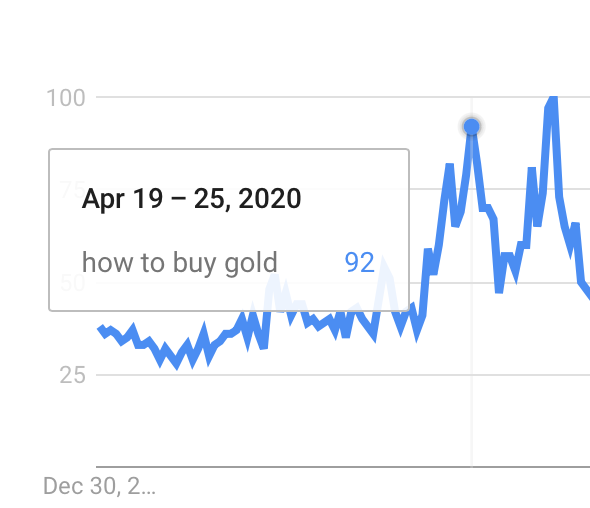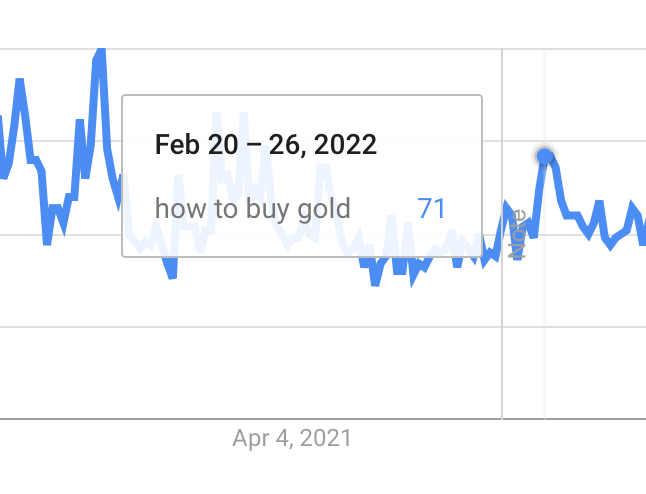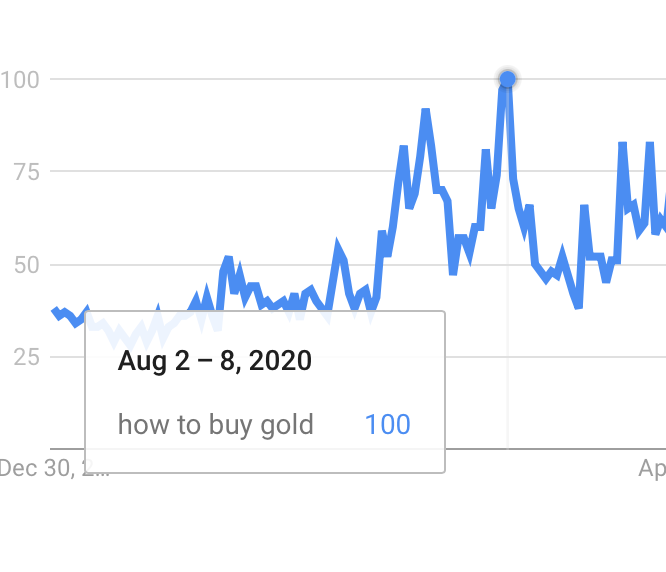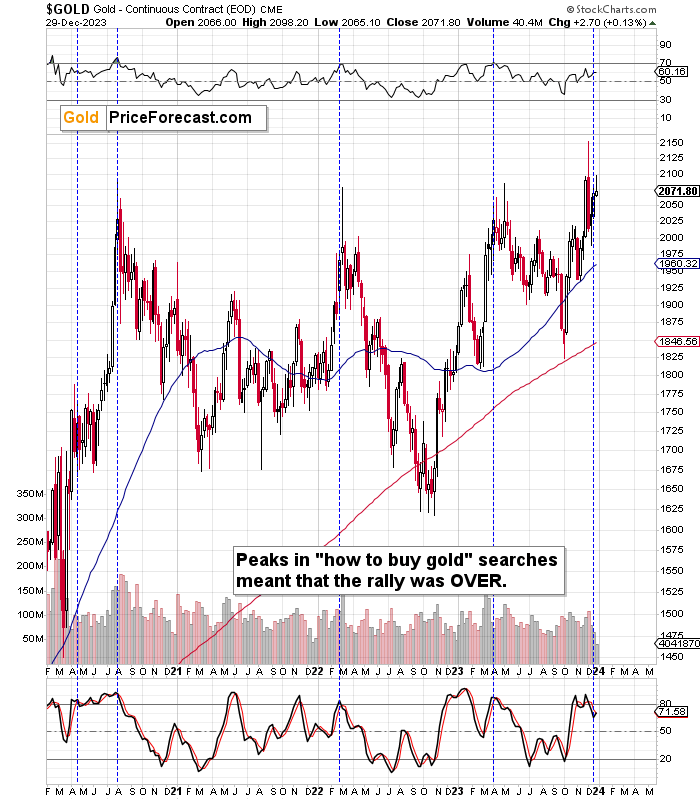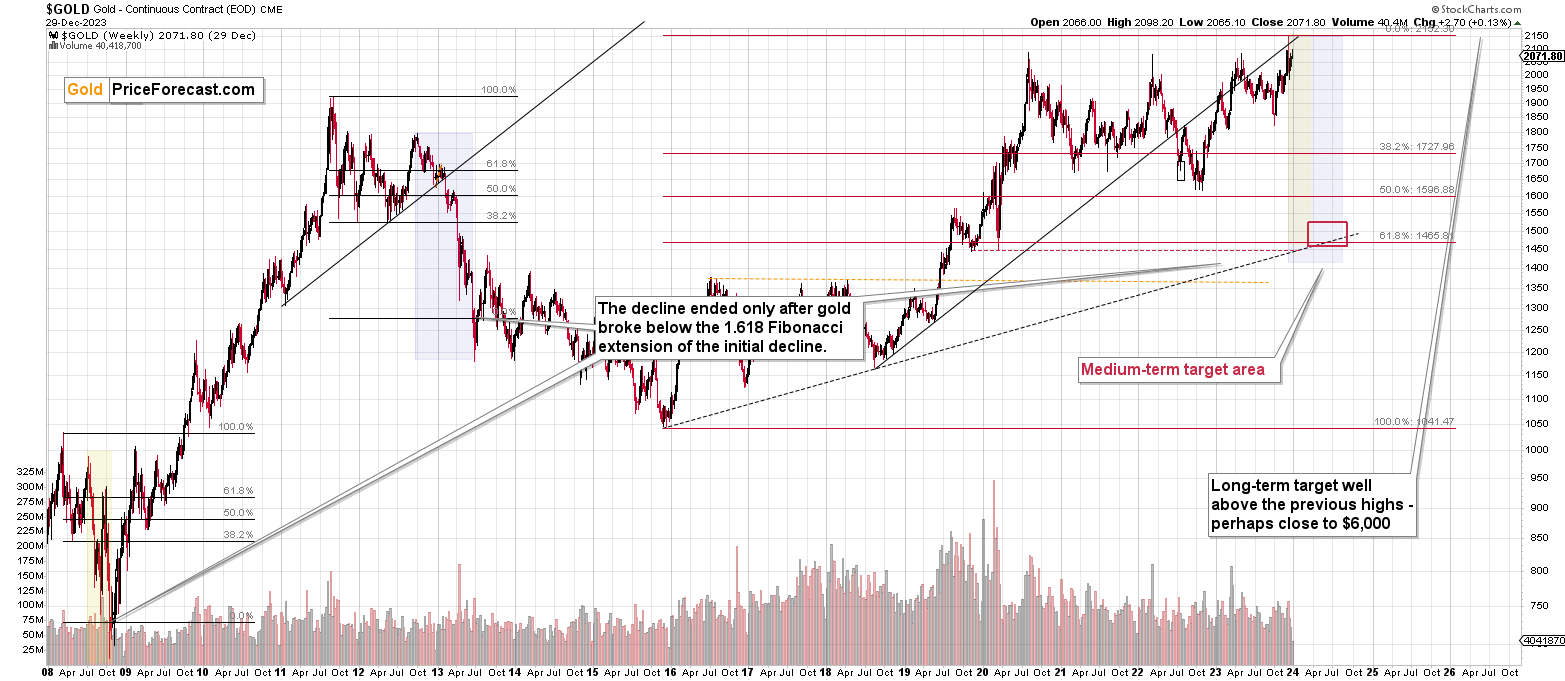Briefly: in our opinion, full (300% of the regular position size) speculative short positions in junior mining stocks (GDXJ) are justified from the risk/reward point of view at the moment of publishing this Alert.
Some might consider an additional (short) position in the FCX.
What a perfect way to end the year! Clear breakouts, obvious breakdowns, and a major signal from tech stocks.
In my recent gold price forecast for January 2024, I wrote about the most important of the recent technical events in gold (gold’s weekly reversal), and in today’s free analysis, I’ll focus on something far less obvious.
It’s been some time since I previously covered the tech stocks – the NASDAQ Index – and it’s about time for me to catch up. After all, the technology appears to be driving the economy higher, and it’s clearly visible on the stock market. Several decades ago, “tech” stocks were a novelty, and now they are the biggest components of stock market indices. Even the most popular company in the automotive industry – Tesla – is essentially a tech company.
The initial blockchain and AI emotional upswings are over, but it doesn’t make them any less important. Remember the dot-com bubble that followed the all-things-internet bull market? It’s the same thing right now but with different tech advancements. Even though the internet was a game-changer for pretty much all aspects of the economy and everyday life, it was also true that the changes did not follow immediately and that the markets got way ahead of themselves. The same goes for blockchain and AI. There were some changes in everyday life, but not tremendous ones – at least not yet.
People’s emotionality remains unchanged despite different geopolitical and technological circumstances, and this also applies to the way in which people react to similar price moves that were triggered by analogous events. (And markets are created by people, right? Plus, algorithms, but those were essentially programmed by humans, anyway.)
Given the above, one would expect that the stock market – at least its tech indices – would behave similarly now to how it behaved around the dot-com peak.
And… That’s exactly what’s happening.
The above chart features the NASDAQ (main line) as well as gold and silver stocks (the XAU Index serves as a proxy; orange line).
There is only one period comparable to the recent over-decade-long rally, and that’s the huge rally that preceded the 2000 top. It’s not like we have to look for the analogy – clear, crystal-clear when looking at the chart for just a second.
I already described the underlying technical changes that triggered both upswings, so I want to focus on something else now. Namely, on the fact that since the long-term momentum was already broken, it’s obvious that the moment that is analogous to what we see right now is what we saw in 2000 after the top.
That was when the momentum in the previous long-term upswing was broken, and the NASDAQ moved below its 50-week moving average (marked with blue). It then moved back up again, but that was not the continuation of the uptrend, even though it looked like it. In reality, it was the first correction after the start of a massive decline.
This is most likely where we see tech stocks right now, as well. We saw the distinct slide below the 50-week moving average, and now we experienced a short-term rally. Some will say that this is just the continuation of the previous long-term uptrend, but the historical analogy suggests otherwise. It seems much more like the first correction after the start of a massive decline.
Now, if tech stocks are about to turn south and then decline in a really substantial manner, what does it imply for the precious metals market?
There are times when tech stocks and precious metals stocks move in the same direction, and there are times when they move in the opposite directions. For example, they plunged together in 2008 and in 2020. This is one of those times, and you can see details in the bottom part of the above chart.
The correlation coefficient that’s visible there takes values from -1 to 1, and the closer it is to -1, the more markets tend to move in the opposite directions, closer to 1 it is, the more markets move in the same direction, and the closer to 0 it is, the more markets move regardless of each other.
At 0.69, the coefficient indicates a situation in which both markets move in the same direction.
This means that a big move lower in the NASDAQ is likely to translate into a big move lower in other stocks and also in mining stocks, quite likely also in copper.
And by bigger, I don’t mean “just big”. Based on the past patterns in the tech stocks, it seems that a 2008-style decline – or worse – is to be expected. This means a huge decline in mining stocks is likely around the corner.
Truth be told, such a bearish storm for mining stocks has been brewing for some time. It’s clear once you look at the correlation coefficient itself and focus on the times when it’s been rising for a long time, and then it started to decline.
I marked the rallies (usually from the 0 level) in the correlation with orange rectangles. In each of the previous cases, when the correlation peaked, it meant that the XAU Index was about to move significantly lower. As you can see on the above chart, the correlation peaked in 2021 and while the XAU has declined since that time, the size of the decline is not yet comparable to what used to happen after similar signals.
This means that gold and silver mining stocks have likely not declined enough just yet. Therefore, they are likely to slide much more in the following months. This move lower started in 2022, and given the recent short-term events, it seems that it’s about to continue. There will be short-term trading opportunities in both directions, but the underlying big trend in the mining stocks is currently down. And if that’s not clear, please consider the fact that while gold is well above its 2008 highs, gold and silver stocks are well below that high. In fact, they are even below their 2006 high.
On a short-term basis, we see that the GDXJ declined on Friday, which means that overall, junior miners declined last week. This means that the situation developed in tune with my previous expectations and, in consequence, my previous comments on its chart, remain up-to-date:
In case of this ETF, the link between big-volume rallies and local tops is not as clear as it is in case of silver, but it’s still present. I marked the similar cases with arrows and in 6 out of 9 such cases, big-volume rallies marked local tops, or those tops followed very soon. Only in 3 out of 9 cases, big rallies followed.
Interestingly, all those three bullish cases were preceded by declines that were much bigger than what we saw recently. This suggests that the bullish analogies are not the correct ones. The bearish ones are.
Moreover, please take a look at the areas that I marked with red rectangles. They mark important tops in the GDXJ ETF. In call those cases, junior miners topped by first declining somewhat, then correcting, and then sliding without looking back. In two out of three cases the second (final) top was below the initial one, and in the remaining case (in early 2022), the second (final) top, was slightly higher than the initial one.
So, is seeing the GDXJ close to the previous top (but still below it) a bullish game-changer? Absolutely not.
In other words, the NASDAQ-based analogy might re-start and the powerful downswing might continue from the current price levels.
All in all, the outlook for the precious metals market remains strongly bearish and the potential for our current trading positions in junior mining stocks remains enormous.
What’s next? While the next 1-3 days are a bit unclear, the entire roadmap that I featured for the GDXJ ETF in my previous Gold Trading Alert remains very much up-to-date.
The markets usually don’t move up or down in a straight line, so some kind of correction is likely to take place in the future, anyway. The question is from what price levels.
My best candidate for the first correction (based on the data that I have available right now) is The $30.5 - $32 range, which is based on the previous lows. I don’t expect a huge rally from those levels, though. Perhaps a move from $30.5 to $32, and then the decline would continue.
The next target is more important. After breaking to new 2023 lows, the move to the 2022 low (close to $26) becomes a good possibility – I marked this area with a green ellipse.
Once this level is reached, I then expect the GDXJ to correct in a more visible manner. After all, at that point, it will be after important breakdowns:
- Below the rising blue support line
- Below the previous 2023 low
- Below the green support line
Consequently, a verification of those breakdowns by a move back to them, would be quite normal. This means a move back to $29 - $30. Then, after a successful verification of those breakdowns, I’d expect the GDXJ to slide lower – to the 2020 low or close to them – at about $20.
There’s also a good possibility of seeing a bottom at about $22, as that’s where we have a downside target based on the head-and-shoulders pattern that is most likely being formed right now. It could also be the case that the GDXJ slides to about $20 on an intraday basis only to recover and close the day at about $22. In a way, both targets would be reached in this case.
There are many IFs around the above-mentioned scenario, and the situation might (and it probably will) change as we go. Remaining open-minded and flexible regarding the new information is key, but having a roadmap is very useful, too, as it shows how things could develop on a more-or-less basis. This can help you prepare for those – or similar – price moves.
Two other notable things happened on the markets on Friday: the price of gold invalidated its breakout, and the USD Index broke above its declining resistance line.
Breakout’s invalidation is a sell sign – simple as that.
The breakout in the USD Index is not yet confirmed, but since we saw it right after a profound daily reversal, it’s likely that it will be confirmed (two more daily closes above the declining resistance line are needed for the breakout to be confirmed).
Of course, this breakout is not the only thing that makes the current outlook for the USD Index very bullish. I described many additional reasons on Friday:
Let’s check the facts:
- The USD Index is after a sizable, short-term decline, which caused it to be very oversold in RSI terms.
- The last two times, when the RSI was similarly oversold, immediately preceded bottoms and rallies (including the yearly bottom).
- The USD Index is slightly above the all-important 100 level, which serves as a strong support due to psychological reasons (everyone notices it as it’s a perfectly round number).
- The USD Index is at its previous bottoms – each time the USD Index got close to the current levels in 2023, it then bottomed and rallied.
- It’s very close to the turn of the month, and the USD Index has a strong tendency to reverse its course close to those moments (as marked with blue, dashed lines). Since the last move was to the downside, the reversal has bullish implications.
There is one additional clue on the long-term chart.
It’s the rising, long-term support line that started in 2011. It was reaching this line that triggered the reversal and caused the yearly bottom to form. Precisely, the USD Index broke slightly below this line, and it was the invalidation of the breakdown that created the bottom.
The USD Index is EXACTLY in the same position right now!
Due to all points listed below the USD Index’s short-term chart, the U.S. currency is very likely to rally at least in the short run. This, in turn, means that it would invalidate the breakdown below the rising, long-term resistance line, just like it did at the 2023 bottom, thus flashing a similar, long-term buy signal.
This is a profoundly bullish combination, even though it might be difficult to view it as such, when focusing on the last few days’ performance.
Since gold is now willing to decline even while the USDX is moving lower… Gold is likely to truly plunge (and the same goes for other commodities, like natural gas) when the USD Index finally rallies. And it looks like both are about to take place.
Besides, when we zoom it, it becomes clear what happened last week.
We saw a weekly reversal! This is a very bullish development, especially that we saw it after a clear short-term downswing. The reversal implies that the decline has just ended, and that we saw a major bottom.
This has profoundly bearish implications for the precious metals market.
Also, please keep in mind that the sentiment toward gold is still extremely positive, which is what we see at major tops. The below quote continues to confirm it:
Have you considered buying gold recently? Like to the point of searching for it online?
Because many people have.
As you can see on the above Google Trends screenshot, the searches for “how to buy gold” just soared, and it’s not the first time that it happened.
Makes one wonder… What happened to gold price in those other cases?
After all, whatever circumstances triggered this jump in the interest in the topic, they are taking place all over again. I don’t mean the state the world is in – I mean the sentiment among gold investors. By estimating the latter, we can also estimate what’s likely to happen to the price, because… The history tends to rhyme, and people’s emotional reactions to what the market is doing remain more or less the same, regardless of the details of the fundamental situation.
I marked one of the moments on the above chart and here are the other notable peaks:
So, what happened to gold price on those occasions?
I marked all-above-mentioned cases with blue, dashed lines and in three out of four cases those were the MAJOR tops. Ones that were followed by hundreds-of-dollar declines in the price of gold.
The only remaining case was when it was still the end of a short-term rally and the start of a pause (that took gold about $100 lower, anyway). This time was truly exceptional, though, because it was right after the covid-scare bottom – it was not a regular course of action.
So, I’d say that in all “regular” cases, the huge increase in interest in buying gold translated into huge declines in the following months. After all, people tend to buy at the tops – that’s exactly what this sentiment analysis proves.
We are at this stage one more time (in many other stocks (the link leads to the most recent stock analysis), too, including some oil stocks). Once again, it’s difficult NOT to buy into the euphoria, even though looking at the situation from a broad perspective practically “screams” WATCH OUT.
Now, you are informed, you are prepared.
And I will continue to keep you – my subscribers – up-to-date, so that what surprises most investors, will not surprise you, but that it will benefit you. We’re on a streak of 11 profitable (unleveraged) trades, after all, and it’s VERY likely that the current trades will increase this streak soon.
Again, as always, I’ll keep you – my subscribers – updated.
= = =
If you’d like to become a partner/investor in Golden Meadow, you’ll find more details in the above link.
Overview of the Upcoming Part of the Decline
- It seems that the recent – and probably final – corrective upswing in the precious metals sector is over.
- If we see a situation where miners slide in a meaningful and volatile way while silver doesn’t (it just declines moderately), I plan to – once again – switch from short positions in miners to short positions in silver. At this time, it’s too early to say at what price levels this could take place and if we get this kind of opportunity at all.
- I plan to switch from the short positions in junior mining stocks or silver (whichever I’ll have at that moment) to long positions in junior mining stocks when gold / mining stocks move to their 2020 lows (approximately). While I’m probably not going to write about it at this stage yet, this is when some investors might consider getting back in with their long-term investing capital (or perhaps 1/3 or 1/2 thereof).
- I plan to return to short positions in junior mining stocks after a rebound – and the rebound could take gold from about $1,450 to about $1,550, and it could take the GDXJ from about $20 to about $24. In other words, I’m currently planning to go long when GDXJ is close to $20 (which might take place when gold is close to $1,450), and I’m planning to exit this long position and re-enter the short position once we see a corrective rally to $24 in the GDXJ (which might take place when gold is close to $1,550).
- I plan to exit all remaining short positions once gold shows substantial strength relative to the USD Index while the latter is still rallying. This may be the case with gold prices close to $1,400 and GDXJ close to $15 . This moment (when gold performs very strongly against the rallying USD and miners are strong relative to gold after its substantial decline) is likely to be the best entry point for long-term investments, in my view. This can also happen with gold close to $1,400, but at the moment it’s too early to say with certainty.
- The above is based on the information available today, and it might change in the following days/weeks.
You will find my general overview of the outlook for gold on the chart below:
Please note that the above timing details are relatively broad and “for general overview only” – so that you know more or less what I think and how volatile I think the moves are likely to be – on an approximate basis. These time targets are not binding nor clear enough for me to think that they should be used for purchasing options, warrants, or similar instruments.
Letters to the Editor
Depending on the nature and target group of your question, feedback or comment, please use the following means of communication:
- For questions or comments that you’d like to get the Community’s response, please use the Ask the Community space so others can contribute to the reply and also enjoy the answers.
- For questions, comments or feedback that you’d like me to comment on / reply to, please send them to Golden Meadow’s support – some clarifications can be provided directly by our experienced support team, and those that are strictly for me, will be forwarded to me and I’ll then provide replies either individually, or in the “Letters to the Editor” section in the Alerts, depending on the nature of the question/comment.
Summary
To summarize, the key thing about the precious metals market is still gold’s extremely important weekly reversal that we saw two weeks ago, which puts the recent (even today’s) rallies in the proper context. What we see now is a perfectly normal post-initial-decline rebound. These moves used to take gold back up to the 50% - 61.8% (approximately) retracements based on the initial size of the decline, and since gold recently moved a bit above its 61.8% retracement and then moved back below it, it seems that the top is in.
The invalidation of breakouts above previous highs as well as the clear relative weakness compared to confirm the bearish outlook.
Additionally, the peak in interest in “how to buy gold” searches makes the current situation even more bearish, as this has been a very accurate detector of massive, medium-term tops.
===
As we’re on a streak of 11 profitable (closed, unleveraged) trades, and – just like I wrote today and in the previous days – it looks like we’re going to see much more of them in the near future, I want to provide you with even more great news!
- It’s possible to get extra 10% discount while extending your subscription for up to three years with a 10% discount from the current prices.
- There are even more savings connected with our Diamond Package that includes Gold Trading Alerts, as well as Oil Trading Alerts and Stock Trading Alerts. The prestigious Diamond Package includes a bundle-offer discount, there’s a 10% discount available for purchasing it for more than one year, and on top of that when using the “DIAMOND10” code when going Diamond there’s an additional 10% discount on top of it all.
Please contact our support to upgrade your subscription to ensure that your paid-for days will be properly transferred over to your new subscription.
To summarize:
Trading capital (supplementary part of the portfolio; our opinion): Full speculative short positions (300% of the full position) in junior mining stocks are justified from the risk to reward point of view with the following binding exit profit-take price levels:
Mining stocks (price levels for the GDXJ ETF): binding profit-take exit price: $28.12; stop-loss: none.
Alternatively, if one seeks leverage, we’re providing the binding profit-take levels for the JDST (2x leveraged). The binding exit level for the JDST: $10.54; stop-loss for the JDST: none.
For-your-information targets (our opinion; we continue to think that mining stocks are the preferred way of taking advantage of the upcoming price move, but if for whatever reason one wants / has to use silver or gold for this trade, we are providing the details anyway.):
Silver futures downside exit price: $20.22 (stop-loss: none)
SLV exit price: $18.62 (stop-loss: none)
ZSL exit price: $24.98 (stop-loss: none)
Gold futures downside exit price: $1,812 (stop-loss: none)
Spot gold downside exit price: $1,792 (stop-loss: none)
HGD.TO – alternative (Canadian) 2x inverse leveraged gold stocks ETF – the exit price: $8.43 (stop-loss: none)
HZD.TO – alternative (Canadian) 2x inverse leveraged silver ETF – the exit price: $19.49 (stop-loss: none)
///
Optional / additional trade idea that I think is justified from the risk to reward point of view:
Short position in the FCX with $27.13 as the short-term profit-take level.
Long-term capital (core part of the portfolio; our opinion): No positions (in other words: cash)
Insurance capital (core part of the portfolio; our opinion): Full position
Whether you’ve already subscribed or not, we encourage you to find out how to make the most of our alerts and read our replies to the most common alert-and-gold-trading-related-questions.
Please note that we describe the situation for the day that the alert is posted in the trading section. In other words, if we are writing about a speculative position, it means that it is up-to-date on the day it was posted. We are also featuring the initial target prices to decide whether keeping a position on a given day is in tune with your approach (some moves are too small for medium-term traders, and some might appear too big for day-traders).
Additionally, you might want to read why our stop-loss orders are usually relatively far from the current price.
Please note that a full position doesn't mean using all of the capital for a given trade. You will find details on our thoughts on gold portfolio structuring in the Key Insights section on our website.
As a reminder - "initial target price" means exactly that - an "initial" one. It's not a price level at which we suggest closing positions. If this becomes the case (as it did in the previous trade), we will refer to these levels as levels of exit orders (exactly as we've done previously). Stop-loss levels, however, are naturally not "initial", but something that, in our opinion, might be entered as an order.
Since it is impossible to synchronize target prices and stop-loss levels for all the ETFs and ETNs with the main markets that we provide these levels for (gold, silver and mining stocks - the GDX ETF), the stop-loss levels and target prices for other ETNs and ETF (among other: UGL, GLL, AGQ, ZSL, NUGT, DUST, JNUG, JDST) are provided as supplementary, and not as "final". This means that if a stop-loss or a target level is reached for any of the "additional instruments" (GLL for instance), but not for the "main instrument" (gold in this case), we will view positions in both gold and GLL as still open and the stop-loss for GLL would have to be moved lower. On the other hand, if gold moves to a stop-loss level but GLL doesn't, then we will view both positions (in gold and GLL) as closed. In other words, since it's not possible to be 100% certain that each related instrument moves to a given level when the underlying instrument does, we can't provide levels that would be binding. The levels that we do provide are our best estimate of the levels that will correspond to the levels in the underlying assets, but it will be the underlying assets that one will need to focus on regarding the signs pointing to closing a given position or keeping it open. We might adjust the levels in the "additional instruments" without adjusting the levels in the "main instruments", which will simply mean that we have improved our estimation of these levels, not that we changed our outlook on the markets. We are already working on a tool that would update these levels daily for the most popular ETFs, ETNs and individual mining stocks.
Our preferred ways to invest in and to trade gold along with the reasoning can be found in the how to buy gold section. Furthermore, our preferred ETFs and ETNs can be found in our Gold & Silver ETF Ranking.
As a reminder, Gold & Silver Trading Alerts are posted before or on each trading day (we usually post them before the opening bell, but we don't promise doing that each day). If there's anything urgent, we will send you an additional small alert before posting the main one.
===
On a side note, while commenting on analyses, please keep the Pillars of the Community in mind. It’s great to provide points that help others be more objective. However, it’s important to focus on the facts and discuss them in a dignified manner. There is not much of the latter in personal attacks. As more and more people join our community, it is important to keep it friendly. Being yourself, even to the point of swearing, is great, but the point is not to belittle other people or put them in a position of “shame” (whether it works or not). Everyone can make mistakes, and everyone does, in fact, make mistakes. We all here have the same goal: to have a greater understanding of the markets and pick better risk-to-reward situations for our trades. We are on the same side.
On another – and final – side note, the number of messages, comments etc. that I’m receiving is enormous, and while I’m grateful for such engagement and feedback, I’m also starting to realize that there’s no way in which I’m going to be able to provide replies to everyone that I would like to, while keeping any sort of work-life balance and sanity ;) Not to mention peace of mind and calmness required to approach the markets with maximum objectivity and to provide you with the service of the highest quality – and best of my abilities.
Consequently, please keep in mind that I will not be able to react / reply to all messages. It will be my priority to reply to messages/comments that adhere to the Pillars of the Community (I wrote them, by the way) and are based on kindness, compassion and on helping others grow themselves and their capital in the most objective manner possible (and to messages that are supportive in general). I noticed that whatever one puts their attention to – grows, and that’s what I think all communities need more of.
Sometimes, Golden Meadow’s support team forwards me a message from someone, who assumed that I might not be able to see a message on Golden Meadow, but that I would notice it in my e-mail account. However, since it’s the point here to create a supportive community, I will specifically not be providing any replies over email, and I will be providing them over here (to the extent time permits). Everyone’s best option is to communicate here, on Golden Meadow, ideally not in private messages (there are exceptions, of course!) but in specific spaces or below articles, because even if I’m not able to reply, the odds are that there will be someone else with insights on a given matter that might provide helpful details. And since we are all on the same side (aiming to grow ourselves and our capital), a ton of value can be created through this kind of collaboration :).
Thank you.
Przemyslaw K. Radomski, CFA
Founder, Editor-in-chief


